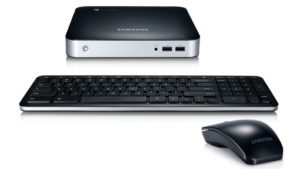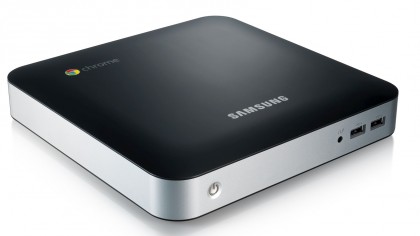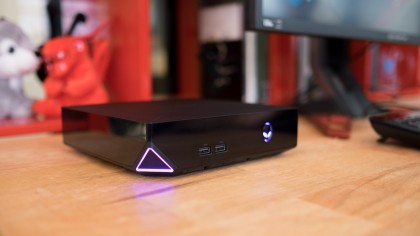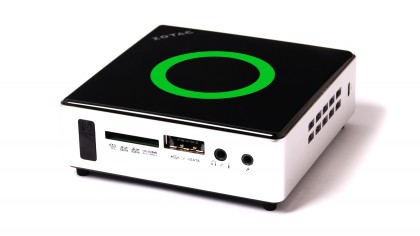[easyazon_link identifier=”B007Y8DJEA” locale=”US” tag=”hometheate0f2-20″] [/easyazon_link]
[/easyazon_link]
Unless you’re a hardcore gamer, you don’t typically think of a PC going in your living room. That’s because, before 2010 at least, 95% of PCs were gigantic monoliths of silicon, which made it difficult to put them anywhere close – let alone inside of – your entertainment center.
But that was six years ago. Fast forward to 2016 where, thanks to massive improvements to processor speed and size, there are now myriad options for those wanting small PCs for their home theater setup.
HTPCs are by no means new, but the fact that you can get a powerful PC that’s the size of an [easyazon_link identifier=”B01L1Y0TCC” locale=”US” tag=”hometheate0f2-20″]Xbox One S[/easyazon_link] and twice as powerful in your living room is awesome and something that not enough media enthusiasts take advantage of.
“So,” you ask yourself, “why would I want a HTPC over an [easyazon_link identifier=”B01L1Y0TCC” locale=”US” tag=”hometheate0f2-20″]Xbox One[/easyazon_link] or [easyazon_link identifier=”B01M0RU6LY” locale=”US” tag=”hometheate0f2-20″]PS4[/easyazon_link]?”
Imagine browsing the web in your living room with a physical mouse and keyboard (trust me, it’s much faster and more efficient than using an Apple TV), playing your favorite video game on the largest screen in your house or creating a library of hundreds of movies and being able to stream them to any of your devices whenever and wherever you are using software like PLEX.
HTPCs, honestly, are just as important to your home entertainment setup as your TV and cable box – and thankfully setting one up is easier than ever before. This guide is living proof.
Consider it your golden ticket to entertainment on the next level.
What is an HTPC?
A Home Theater PC (HTPC) is one that you put in your living room to browse the web, watch movies, or game in your living room. HTPCs now come in all sorts of form factors and can be the size of a gaming consoles, or they can be as tiny as an Apple TV. (If you’re looking for the tiniest of PCs that are just capable of storing and streaming movies, check out our guide to the [easyazon_link identifier=”B00US6DCFG” locale=”US” tag=”hometheate0f2-20″]Best Kodi/XBMC boxes of 2016[/easyazon_link].)
Over the last few years HTPCs have not only gotten smaller, but also cheaper, too. They can be purchased – or built – at all different price points to accommodate your wants and needs.
To that end, we’ll divide this guide up into a two sections – How to choose a gaming HTPC and How to choose a media box and/or streaming machine.
[easyazon_link identifier=”B007Y8DJEA” locale=”US” tag=”hometheate0f2-20″] [/easyazon_link]
[/easyazon_link]
How to build/buy a gaming HTPC
PC Gaming in the living room is much more practical than it was in the past, as cases have gotten smaller and peripheral companies like Corsair, Roccat, SteelSeries and Razer have broken into the living room space with lapdesk mice and keyboards.
Gamers have two different options when looking for a gaming HTPC: You can either build one yourself, or go with one built by a PC vendor like iBuyPower, Origin, Dell or HP.
Building an HTPC typically will give you the best bang for your buck when it comes to performance. If want to buy a prebuilt system we recommend going with a setup which has an Intel Core i5 Skylake CPU, an RX 480 or a GTX 1060 video card and at least 8GB of RAM. The parts described can play games at 1080p smoothly.
Now, you can swap out the parts based on your particular budget and what parts you may have laying around the house already, but here’s what we’d recommend to first-time builders:
- CPU: Intel Core i5-6400
- Motherboard: MSI H110I Pro Mini ITX
- RAM: Crucial 8GB (2 x 4GB) DDR4 2133 (PC4 17000)
- Storage: OCZ TRION 150 240GB
- Video card: ZOTAC GeForce GTX 1060 ZT-P10600A-10L
- Case: Cooler Master Elite 130
- Power supply: EVGA 500 B1
- Blu-ray drive: LG WH14NS40
- Wireless keyboard: Logitech K400 Plus
- OS: Windows 10
Why we chose these parts:
We opted for an i5-6400 which gives us Intel’s latest Skylake architecture and its the least expensive quad-core at $180 (£169). The motherboard is an MSI H110l board, which supports our Intel CPU and the 8GB of DDR4 RAM that we chose. For our video card we chose a [easyazon_link identifier=”B01IEKYD5U” locale=”US” tag=”hometheate0f2-20″]GTX 1060[/easyazon_link], one of the fastest cards you can get at the price point, though, it was a toss up between this card or an RX 480. We opted for a [easyazon_link identifier=”B01F9G43WU” locale=”US” tag=”hometheate0f2-20″]240GB SSD[/easyazon_link] instead of a mechanical hard drive so that our games and media load quickly – but you’re free to swap in an old mechanical hard drive if that’s what you have sitting around somewhere.
In the parts list we also included a [easyazon_link identifier=”B014W3EM2W” locale=”US” tag=”hometheate0f2-20″]500W Power Supply[/easyazon_link] which you should be able to find on the cheap. The wireless keyboard we chose is one from [easyazon_link identifier=”B014EUQOGK” locale=”US” tag=”hometheate0f2-20″]Logitech, the K400 Plus[/easyazon_link], as it offers a keyboard and a built trackpad for a good price. Wrapping everything together is a CoolerMaster Elite 130 case making the whole PC barely larger than a shoebox.
Note: We should mention that smaller PC builds are more difficult than a standard PC build, as the case is smaller making everything more compact and crammed together.
[easyazon_link identifier=”B01F3R9GWC” locale=”US” tag=”hometheate0f2-20″] [/easyazon_link]
[/easyazon_link]
How to build/buy a media box
Those looking to get a PC in their living room to stream movies can get a Chromebox or an inexpensive small Windows PC. These mini PCs come with either [easyazon_link identifier=”B01019T6O0″ locale=”US” tag=”hometheate0f2-20″]Windows 10[/easyazon_link] or Chrome OS installed on them, and typically contain 2GB or 4GB of RAM, a 32GB SSD, and a Celeron processor, which is more than enough for streaming movies on the web.
What’s the difference between the two? [easyazon_link identifier=”B00ZYKTQA6″ locale=”US” tag=”hometheate0f2-20″]Chromeboxes[/easyazon_link] are new to the marketplace. The tiny PCs come with Google’s Chrome OS, which lets users watch movies, edit documents, and listen to music using Google Chrome. The limitation to think about in [easyazon_link identifier=”B01DBGVB7K” locale=”US” tag=”hometheate0f2-20″]Chromebooks[/easyazon_link] is that you are limited to what you can do in a Chrome browser right now.
If you want to install third-party there currently is no way for example to download VLC Media Player, or install an offline video game. Chrome OS is going to be getting Android App this fall on all new Chrome OS devices and also some older ones will get this feature too.
Why would you ever want a Chromebox if they have limitations as your living room PC? Chrome OS is fast, like really fast. The OS boots up in less than 5 seconds. Chrome OS does browsing really well like watching Netflix, YouTube, Hulu, or Amazon Prime Videos. Chrome OS based PCs often come with 4GB of RAM installed and run about $150/£100. Windows PCs on the other hand come with 2GB usually, which can hamper a person’s ability to multitask.
Which Chromebox should you pick?
The [easyazon_link identifier=”B01BC6ZJVU” locale=”US” tag=”hometheate0f2-20″]Lenovo ThinkCentre Chromebox[/easyazon_link] is a well-rounded Chrome OS PC, which comes with 4GB of RAM, a Celeron 3205U CPU, and a 16GB SSD. The PC measures 7 inches x 7.2 inches x 1.4 inches (LxWxH).
The other option you have for an living room media player PC is a small Windows PC. Like Chromeboxes, there are many options that come configured with 2 to 4GB of RAM, a Celeron processor and 32GB or 64GB of storage.
The reason that you would opt for a Windows PC over a Chromebox would be flexibility. If you want to be able to run VLC Media Player or a different browser like FireFox you’d want to go with a mini Windows PC over a Chromebox. The sacrifice you’re most likely going to make is getting 2GB less RAM, which will hamper your multitasking experience.
[easyazon_link identifier=”B01GE9QMO8″ locale=”US” tag=”hometheate0f2-20″] [/easyazon_link]
[/easyazon_link]
Which Mini Windows PC should you pick?
The [easyazon_link identifier=”B01GE9QMO8″ locale=”US” tag=”hometheate0f2-20″]Zotac B Series BI323[/easyazon_link] mini PC is a relatively cheap HTPC that can handle media streaming without much of a problem. The unit has a Celeron N3150 processor and comes installed with Windows 10 and 2GB of RAM. It also comes with a teeny 32GB SSD. Lastly, the Zotac B comes wrapped in a small case which measures 7.4 x 1.7 x 7.4 inches (LxWxH).
A PC in your living room can bring the great input methods of mouse and keyboard to your couch. In the end it makes searching for movies, TV shows, and YouTube clips much easier than a [easyazon_link identifier=”B00UJ3IULO” locale=”US” tag=”hometheate0f2-20″]Roku 3[/easyazon_link] or [easyazon_link identifier=”B01NCJZBEO” locale=”US” tag=”hometheate0f2-20″]Apple TV[/easyazon_link] ever could.
Whether you want to game or stream media or game on your TV there is a PC for entertainment needs. We hope that this guide helps you in figuring out which one is right for you.
Have a Chromebox or HTPC build you really like? Let us know in the comments below.

Leave a Reply
You must be logged in to post a comment.